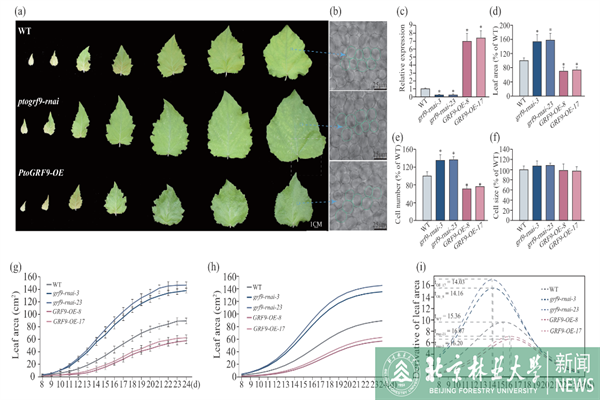Latest news
Recently, a team led by Professor Zhang Deqiang from the College of Biological Sciences and Biotechnology has made substantial progress in the field of forest genetics. Their research paper, published in the prestigious journal New Phytologist, is titled "Temporal dynamics of genetic architecture governing leaf development in Populus." It offers valuable insights into the dynamic genetic foundations that shape leaf development and illuminates the regulatory role of PtoGRF9 in this intricate process.

Leaf development is a multifaceted and dynamic process orchestrated by a myriad of genes to shape the proper size and morphology. The dynamic genetic network underlying leaf development remains largely unknown.Utilizing a synergistic genetic approach encompassing dynamic genome-wide association study (GWAS), time-ordered gene co-expression network (TO-GCN) analyses and gene manipulation, researchers explored the temporal genetic architecture and regulatory network governing leaf development in Populus.The research team identified 42 time-specific and 18 consecutive genes that displayed different patterns of expression at various time points, then constructed eight TO-GCNs that covered the cell proliferation, transition, and cell expansion stages of leaf development. Integrating GWAS and TO-GCN, researchers postulated the functions of 27 causative genes for GWAS and identified PtoGRF9 as a key player in leaf development. Genetic manipulation via overexpression and suppression of PtoGRF9 revealed its primary influence on leaf development by modulating cell proliferation. Furthermore, they elucidated that PtoGRF9 governs leaf development by activating PtoHB21 during the cell proliferation stage and attenuating PtoLD during the transition stage.In summary, PtoGRF9 demonstrates dual functionality as both a transcriptional activator and repressor, orchestrating the nuanced processes of leaf development. The data are consistent with a model whereby, during the initial cell proliferation stage, high PtoGRF9 expression levels limits cell proliferation by activating the expression of PtoHB21. As leaf development advances, the decline in PtoGRF9 expression upregulates PtoLD leading to leaf expansion.

Professor Zhang Deqiang is the corresponding author of the paper, Li peng, He Yuling and Xiao Liang are the first authors. The study was supported by the State '14.5' Key Research Program of China (no. 2021YFD2200101), the Project of the National Natural Science Foundation of China (nos. 32170370 and 32370396), Key research and development project of Zhejiang Province (no. 2021C02054) and the 111 Project (no. B20050).
Paper link: https://nph.onlinelibrary.wiley.com/doi/10.1111/nph.19649











